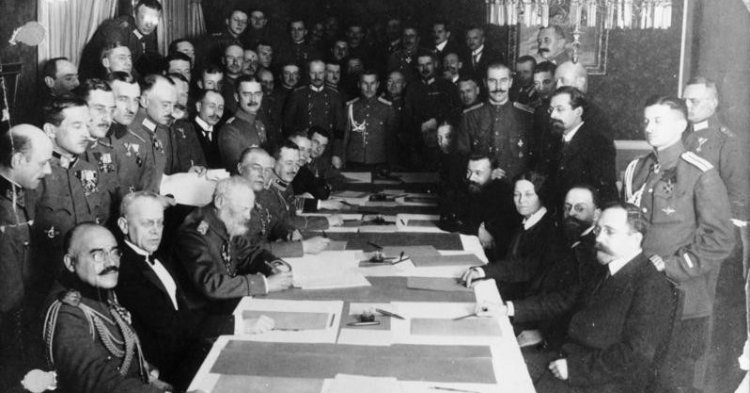When the Bolsheviks stormed the Winter Palace in St. Petersburg in October 1917 under the leadership of Lenin, when the Provisional Government fell and the Bolsheviks seized power, Russia’s soldiers had already been fighting against the Central Powers (formed by the German Reich, Austria-Hungary, the Ottoman Empire and Bulgaria) in the First World War for more than three years. Lenin came out against the War, which he had already labelled ‘bourgeois, imperialist and dynastic’ in his essay ’The Tasks of Revolutionary Social-Democracy in the European War’.
However, the fact that the Bolsheviks initiated the negotiation of a ceasefire with the Central Powers shortly after seizing power was for not only ideological, but also pragmatic reasons: the Revolutionaries wanted to consolidate their rule in a Russia that was weary of war. Russia’s endeavour also came at a convenient time for the Central Powers: their aim after the peace agreement was to intensify their focus on the Western Front and to rally their forces.
In January 1918, the peace negotiations began in the Belarusian city of Brest-Litowsk with Leo Trotzki as chief negotiator on the Russian side. He played for time, hoping that the Revolution would also come in Germany. In the meantime, the German delegation signed a peace treaty with Ukraine for tactical reasons, which is also referred to as ‘Brotfrieden’ (peace for bread), because it linked the recognition of Ukrainian independence with the supply of grain to the German Reich. However, at first, the Bolsheviks did not let themselves be swayed by this. Only when the Germans later began another campaign into Russian territory and gained a lot of ground did the new Russian leadership relent. On 3 March the peace treaty was signed in Brest-Litowsk.
The result was devastating for Russia: Poland and the Baltic region became German satellite states, Finland and Ukraine became independent. Georgia, Armenia and Azerbaijan passed to the Ottoman Empire. As a result, Russia lost a quarter of its territory in which 50 million people lived. Additionally, six Million Reichsmark were agreed upon as reparations. It is a peace treaty that brings to mind the Treaty of Versailles, signed a year later, because it humiliated the defeated party.
In the end, the ostensible victory fell back on the Germans (c.f this radio report on the NDR). A million German soldiers stayed behind in the newly independent Eastern European states in order to support them. In the meantime, the Central Powers lost the war on the Western Front. The treaty had however given the Bolsheviks valuable time to establish their regime in Russia. Without the peace treaty, Europe’s history would have certainly developed differently.


Follow the comments: |
|
